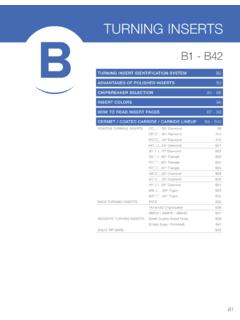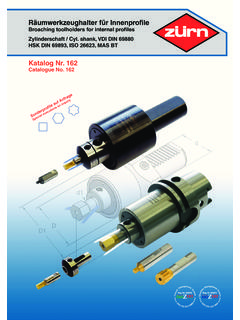Transcription of Milling of Nickel-Based Alloys - Greenleaf Global …
1 Greenleaf SalesPhone: 814-763-2915 800-458-1850 Fax: Hard Materials 45-65 RcWG-300 is successfully used for the turning of hard materials other than Nickel-Based Alloys in the range of 45-65 Rc. The outstanding hardness, combined with thehigh strength imparted by the reinforcing silicon carbidewhiskers, makes possible the machining of many materialspreviously workable only by grinding. Some areas wherethe greatest savings have been shown are in the heattreated alloy steels, die steel, weld overlays, hard facingsand hard in Nickel-Based Alloys , speeds can be increased up to8x those used for uncoated tungsten carbide tools and 4xthose of coated carbide above graph (Figure 72)gives starting points forspeeds and feeds based upon material hardness. In hardturning the use of a light hone on the insert such as edgepreparation T1A may help reduce shouldnot be this application we also recommend theuse of an ANSI toolholder system which inherently has a five-degree double-negative your job is in the 45 to 65 Rc range, chances are thatGreenleaf WG-300 can increase productivity and cutmachining costs 72 WG-300 Machining Recommendations for Hardened ,0640,1270,0301221832440,191 FeedRatePerRevolutionSurfaceSpeedPerMinu teRcScleroscope INCHMMFEETMETERSS tarting Point Based on Insert RNGN-45 (RNGN-120700) =.
2 060" (1,5 mm)Example: 52100 Steel, 58 Rc 530 feet/min (162 m/min.) .0042 in/rev (0,107 mm/rev) Milling of Nickel-Based AlloysMilling can be compared to interrupted machining in each insert is in and out of the cut duringeach revolution, the desirable temperature ahead of the tool is not easily achieved and calls for increased surfacespeed, reduced feed per tooth or a combination of both. Itcan be surprising how much extra speed is needed in someoperations to get the heat back compared to machining thesame material continuously as in turning. The increase canbe many times the turning a cutter designed for carbide is employed, new problemscan carbide insert Milling cutter designs do notincorporate safety features to prevent components fromdislodging at high use of coolants is not Milling , unlike turning, the chip can be generated fromthin to thick as in conventional or up Milling or thick to thinas in climb or down Milling .
3 It is highly recommended touse the climb Milling technique to avoid high heat in a thinsection of the chip which encourages chip welding and re-cutting of the chips which reduces tool 800-458-1850 Greenleaf SalesPhone: 814-763-2915 800-458-1850 Fax: summarize, when Milling with WG-300:1. Increase the speed from the turning recommendations inFigure 13according to the width of Reduce the feed rate recommended for turning in Figure 13by about 50%.Remember, this is feed pertooth, not per revolution of the Milling Be sure to use a Greenleaf high-velocity Milling cutter or a cutter designed specifically for use with ceramics athigh surface Speed Increase for Millingwith Various Declining Widths of CutIn a Milling operation the width of cut has a direct bearingupon the temperature generated ahead of the inserts. Asthe width is decreased,so is the temperature since eachinsert now passes through air for a longer time than itactually cuts 73shows the percentage of increase to the speedsgiven in the graph (Figure 13)for various declining widths are also expressed as percentages of thecutter diameter so the chart can be applied to all cutter the very best, a Milling insert can only be cutting 50% of each revolution if the path of cut is equal to the cutterdiameter.
4 For this reason, it will always be necessary toincrease speed and reduce feed compared to the turningrecommendations in Figure 13to achieve the same temperature of a Ceramic Milling ApplicationThe following data indicates outstanding success with a ceramic Milling application:Material ..WaspaloyCondition ..ForgingHardness ..41 RcOperation ..Rough and Finish MillingCutter Diameter ..3" (76 mm) WSRN-60003 Number of Inserts ..4 Depth of cut (rough) .. " (1,27 mm)Depth of cut (finish) .. " (0,64 mm)Insert ..RNGN 45 T2 (120700)Grade ..WG-300 Speed ..3144 SFM (958 m/min)Feed ..64 ipm (1,6 m/min)Feed per tooth .. " (0,1 mm)This application resulted in an 80-to-1 reduction in the cutting time cycle over 73 Recommended Speed Increase for Milling with Various Declining Widths of CutWidth Of CutCutter DiameterRotationFeedWidth of Cutin Percentage ofCutter DiameterEngaged inWorkpiece100%90%80%70%60%50%40%30%20%1 0%Surface Speedin Percentage of Graph(Figure 13)125%150%220%280%340%400%460%540%660%7 80%ATI





